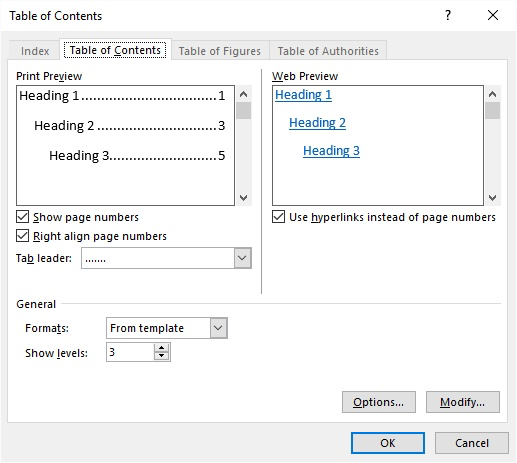Please Note: This article is written for users of the following Microsoft Word versions: 2007, 2010, 2013, 2016, 2019, 2021, and Word in Microsoft 365. If you are using an earlier version (Word 2003 or earlier), this tip may not work for you. For a version of this tip written specifically for earlier versions of Word, click here: Creating a Table of Contents from Heading Levels.
Written by Allen Wyatt (last updated December 16, 2023)
This tip applies to Word 2007, 2010, 2013, 2016, 2019, 2021, and Word in Microsoft 365
If you are writing a long document or a book, you may want to create a Table of Contents (TOC) for your document. The easiest way to create a TOC is to use heading levels, as defined by the Word styles. To do this, follow these steps:

Figure 1. The Table of Contents tab of the Table of Contents dialog box.
Note, again, that this process creates a TOC based on heading levels within your document. This means that your document must use heading styles throughout it. (Heading styles are named "Heading 1," "Heading 2," etc.) If you apply these as you are creating your document—or if you go back and apply the styles later—then creating the TOC is a snap, as described above.
WordTips is your source for cost-effective Microsoft Word training. (Microsoft Word is the most popular word processing software in the world.) This tip (5950) applies to Microsoft Word 2007, 2010, 2013, 2016, 2019, 2021, and Word in Microsoft 365. You can find a version of this tip for the older menu interface of Word here: Creating a Table of Contents from Heading Levels.

Learning Made Easy! Quickly teach yourself how to format, publish, and share your content using Word 2021 or Microsoft 365. With Step by Step, you set the pace, building and practicing the skills you need, just when you need them! Check out Microsoft Word Step by Step today!
Word allows you to easily add a table of contents to your documents. If you find that some of your document headings ...
Discover MoreGenerating a table of contents is easy in Word. Changing how that table of contents looks is also easy, provided you ...
Discover MoreWord is great at creating a simple, straightforward table of contents. If you want a more non-traditional TOC, however, ...
Discover MoreFREE SERVICE: Get tips like this every week in WordTips, a free productivity newsletter. Enter your address and click "Subscribe."
There are currently no comments for this tip. (Be the first to leave your comment—just use the simple form above!)
Got a version of Word that uses the ribbon interface (Word 2007 or later)? This site is for you! If you use an earlier version of Word, visit our WordTips site focusing on the menu interface.
Visit the WordTips channel on YouTube
FREE SERVICE: Get tips like this every week in WordTips, a free productivity newsletter. Enter your address and click "Subscribe."
Copyright © 2025 Sharon Parq Associates, Inc.
Comments